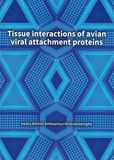Tissue interactions of avian viral attachment proteins

Ambepitiya Wickramasinghe, Iresha
- Promoter:
- Prof.dr. A. (Andrea) Gröne
- Co-promoter:
- Dr. M.H. (Hélène) Verheije
- Research group:
- Gröne
- Date:
- September 9, 2015
- Time:
- 12:45 h
Summary
Viruses can infect a wide range of hosts; varying from bacteria and plants to animals and humans. While many viral infections may pass unnoticed, some are of major importance due to their implications on health and welfare of plants, animals and/or humans. In particular, viruses that can infect avian hosts have been studied intensively due the occurrence of the pandemics of highly pathogenic influenza A virus infection or “bird flu’’. Viral infections in domesticated birds can result in huge economic losses in the poultry industry. In wild birds, infections may be asymptomatic, but these viruses may remain in these birds and thus they may act as reservoirs. Particularly wild birds may be ideal reservoirs because of their ability fly over long distance and hence they can effectively spread viruses along the migration routes. Coronaviruses in birds are considered economically important pathogens worldwide. They are classified in the genus Gammacoronaviridae, family Coronaviridae. Infectious bronchitis virus (IBV) is the prototype of this group and can cause severe respiratory disease in chickens. In addition, coronaviruses have been reported to induce respiratory disease in other avian species, including pheasants, pigeons and peafowls. Interestingly, apart from infecting the respiratory system IBV is capable of replicating in other organ systems within a specific host, indicating that IBV has an extended virus tropism. On the other hand, some other gammacoronaviruses, for an example turkey, guineafowl and quail coronaviruses have been observed to possess a more restricted tropism by limiting the infection to the gastrointestinal system. Viral and host factors that enable the attachment of a virus to the target host cell are crucial in defining viral tropism. This thesis was aimed to identify these factors for avian coronaviruses in view of understanding the mechanism behind viral tropism. To this end several novel methods were established to study the first step in the avian coronavirus infection cycle. While Chapter 1 gives a introduction to the aims of this thesis chapter 2 provides an overview on the function of the gammacoronavirus spike proteins and its role in defining the tropism and susceptibility. In addition it summarizes the reported data on tissue interactions of the coronaviral spike. Chapter 3 describes the use of recombinant spike proteins as a tool to understand the tropism of gammacoronaviruses using infectious bronchitis virus, the prototype of the group, as an example. The novel avian tissues microarray and its benefits in view of defining organ and susceptibility to a particular coronavirus are demonstrated in Chapter 4. Chapter 5 reveals a novel receptor for enterotropic gammacoronaviruses and receptor specificity towards defining their restricted enterotropism. While differences in the tissue interactions of mutated influenza virus attachment proteins, HAs, have been shown in Chapter 6 the detailed protocol of evaluating tissue interactions with protein histochemistry is described in Chapter 7. Overall we provide evidence for viral and host determinants that mediate avian coronavirus tropism. In the final discussion (Chapter 8) remaining gaps in defining the tropism and pathogenicity of avian coronaviruses will be discussed.